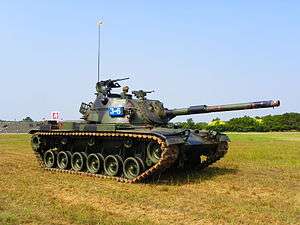CM-11 Brave Tiger
| CM-11 Brave Tiger M-48H Patton | |
|---|---|
|
ROCA CM-11 in Hukou Camp after Exercise | |
| Type | Main Battle Tank |
| Place of origin |
|
| Service history | |
| In service | 1990-present |
| Used by |
|
| Production history | |
| Designer | Republic of China Armored Vehicle Development Center |
| Designed | 1984 |
| Manufacturer | Republic of China Armored Vehicle Development Center |
| Unit cost | US$ 300 million |
| Number built | 450 |
| Specifications | |
| Weight | 50 tonnes (55 short tons; 49 long tons) |
| Length |
6.95 meters (22 ft 10 in) (hull) 9.30 meters (30 ft 6 in) (cannon forward) |
| Width | 3.63 meters (11 ft 11 in) |
| Height | 3.09 meters (10 ft 2 in) |
| Crew | 4 |
|
| |
Main armament | 105 mm (4.1 in) M68 gun |
Secondary armament |
.50 BMG (12.7×99mm) M2 Browning |
| Engine |
Continental AVDS-1790-2C air-cooled Twin-turbo diesel engine 750 hp (560 kW) |
| Power/weight | 15 hp/t |
| Suspension | Torsion bar suspension |
Operational range | 480 kilometers (300 mi) |
| Speed | 48 km/h |
The CM-11 Brave Tiger (勇虎式戰車) is a Main Battle Tank (MBT) that was developed by the United States General Dynamics and the Republic of China Army (ROCA) Armored Vehicle Development Center[1]
It was introduced to the public on 14 April 1990. Being a variant of the M48 Patton, it is also known as the M48H Main Battle Tank.
Development History
The Republic of China established the Armored Vehicle Development Center in 1980 for developing military armored vehicles, and cooperated with General Dynamics to develop CM-11.[2] Developing it had two main purposes, first was to avoid the limitations set by the US-PRC Joint Communique (17 August Communique), second was to let the ROCA to acquire Second Generation MBT.
The CM-11 is a hybrid tank using the M48A3 turret with the M60A3 tank hull, combine with the new M1 tank's Fire-Control System (FCS). The United States called it M48H, while the "H" means Hybrid, and the Republic of China called it CM-11 and named it Brave Tiger.
Design
In 1988, two prototype CM-11 was finished, and was ordered to build 450 CM-11. The M60A3 hull was procured from the United States in 1987, and the M48A3 turrent and the M68A1 105mm main cannon was produced by the Army Ordnance Maintenance and Development Center. The Commander's turret was procured from Israel with a M2 Browning 12.7 mm machine gun, the loader operates a M240 7.62 mm machine gun, the coaxial machine gun is also a M240. Both sides of the turret has mounted one M239 Smoke Grenade Launcher, like the M60A3 tank.
Advantages
The greatest features and advantages of the CM-11 is it has the same level of digital/ analogy hybrid ballistic calculator as the M1A1 Abrams MBT; it has a two-dimensional sighting and gun stabilization system, more complete than the M60A3's one-dimensional stabilizing device; combining the AN/VSG-2 Thermal imager, AN/VVS-2 Image Intensifier, AN/GVS-5 Nd-YAG Laser rangefinder, allowing the CM-11 to have Fire-on-the Move and Night Combat capabilities, it also have the highest probability of first round hit compare to all ROCA tanks.
Disadvantages
The greatest disadvantages of the CM-11 is its outdated design and armor. When facing the People's Liberation Army's current MBTs, the Type 96G and Type 99's 125 mm main cannon, the weak protection of CM-11 needs improvement. Although the ROCA knew this disadvantage very early, and tried to introduce the French GIAT Explosive Reactive Armor (ERA), but the additional ERA caused excessive stress on the torsion bars, so until this problem is solved, there is no plan to install any additional armors on CM-11. Also its engine is rather old, with lower power.
On 2012, during the Spring Festival combat readiness drill (春節戰備操演) of ROCA 6th Army Corps, 542 Armor Brigade, first shown the ERA developed by National Chung-Shan Institute of Science and Technology (CSIST) on a CM-11. This ERA is developed by CSIST, with the angle made on steel plates, it can deflect the incoming round and ricochet it, to prevent the round directly penetrates into the hull and cause damages to the crews or equipment, it mainly protects the hull from RPGs and rounds from tanks.
-

CM-11 side view
-

Rear view of CM-11
See also
References
- ↑ The Armored Vehicle Development Center is later called Army Ordnance Maintenance and Development Center, or OMDC for short.
- ↑ Global Defense Magazine Vol. 70, June 1990
